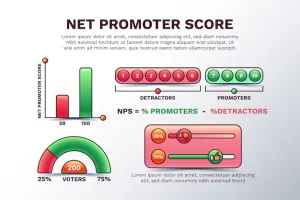The Net Promoter Score (NPS) and branding are deeply interconnected, forming a bidirectional relationship where each influences and informs the other. Understanding this connection is essential for businesses aiming to enhance customer loyalty and brand equity.

1. Branding Drives NPS
First and foremost, strong branding plays a crucial role in shaping NPS.
- Customer Loyalty and Advocacy: A well-defined brand fosters emotional connections, trust, and loyalty, ultimately leading to higher NPS scores. When a brand consistently delivers on its promises, customers are more likely to become “Promoters” who enthusiastically recommend the brand to others.
- Differentiation: Moreover, effective branding helps a company stand out from competitors by creating unique value. This distinct positioning makes customers more inclined to endorse the brand, directly contributing to an improved NPS.
2. Net Promoter Score Reflects Brand Health
On the other hand, NPS serves as a valuable indicator of brand perception.
- Measuring Brand Perception: A high NPS suggests that customers view the brand positively and are willing to advocate for it, reinforcing strong brand equity. Conversely, a low NPS may indicate a gap between brand promises and actual customer experiences.
- Impact on Word-of-Mouth Marketing: Additionally, Promoters play a key role in amplifying a brand’s reputation. Their referrals help enhance brand awareness and credibility, both of which are essential for long-term success.
3. Net Promoter Score Informs Brand Strategy
Beyond serving as a performance metric, NPS also provides valuable insights for refining brand strategy.
- Feedback Loop for Improvement: By analyzing NPS data—especially reasons for lower scores—companies can identify gaps in the brand experience. This allows them to refine their messaging, improve customer journeys, and better align operations with their brand values.
- Customer-Centric Adjustments: Furthermore, addressing concerns raised by Detractors can significantly improve brand perception. By resolving customer pain points, businesses can turn critics into advocates, ultimately strengthening overall brand equity.
4. Synergy with Brand Equity
Notably, NPS and brand equity work together to create a reinforcing cycle of growth.
- Enhancing Brand Value: A high NPS contributes to brand equity by driving customer referrals and fostering loyalty. As Promoters act as unpaid brand ambassadors, they extend the brand’s reach and credibility, leading to improved market positioning and financial performance.
5. Limitations and Complementary Metrics
While NPS is a powerful indicator of customer advocacy, it does not provide a complete picture of brand health.
- The Need for a Holistic Approach: Since NPS primarily measures advocacy, it should be supplemented with other branding metrics, such as brand awareness surveys or sentiment analysis. This comprehensive approach ensures a more accurate assessment of brand performance.
In essence, NPS and branding share a symbiotic relationship. Branding shapes customer perceptions, which influence NPS, while NPS provides data-driven insights to strengthen brand strategy and equity. By understanding and leveraging this dynamic, businesses can build stronger customer relationships and achieve sustained success.